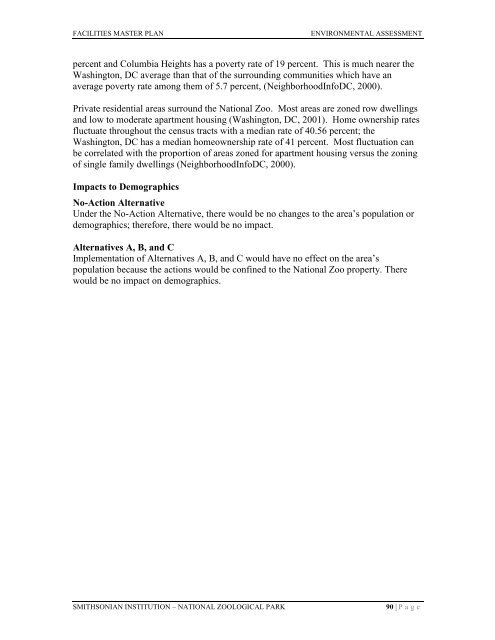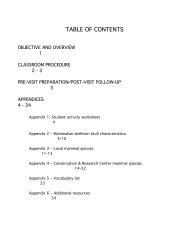facilities renewal master plan - National Zoo - Smithsonian Institution
facilities renewal master plan - National Zoo - Smithsonian Institution
facilities renewal master plan - National Zoo - Smithsonian Institution
Create successful ePaper yourself
Turn your PDF publications into a flip-book with our unique Google optimized e-Paper software.
FACILITIES MASTER PLAN ENVIRONMENTAL ASSESSMENT<br />
percent and Columbia Heights has a poverty rate of 19 percent. This is much nearer the<br />
Washington, DC average than that of the surrounding communities which have an<br />
average poverty rate among them of 5.7 percent, (NeighborhoodInfoDC, 2000).<br />
Private residential areas surround the <strong>National</strong> <strong>Zoo</strong>. Most areas are zoned row dwellings<br />
and low to moderate apartment housing (Washington, DC, 2001). Home ownership rates<br />
fluctuate throughout the census tracts with a median rate of 40.56 percent; the<br />
Washington, DC has a median homeownership rate of 41 percent. Most fluctuation can<br />
be correlated with the proportion of areas zoned for apartment housing versus the zoning<br />
of single family dwellings (NeighborhoodInfoDC, 2000).<br />
Impacts to Demographics<br />
No-Action Alternative<br />
Under the No-Action Alternative, there would be no changes to the area’s population or<br />
demographics; therefore, there would be no impact.<br />
Alternatives A, B, and C<br />
Implementation of Alternatives A, B, and C would have no effect on the area’s<br />
population because the actions would be confined to the <strong>National</strong> <strong>Zoo</strong> property. There<br />
would be no impact on demographics.<br />
SMITHSONIAN INSTITUTION – NATIONAL ZOOLOGICAL PARK 90 | P a g e

















